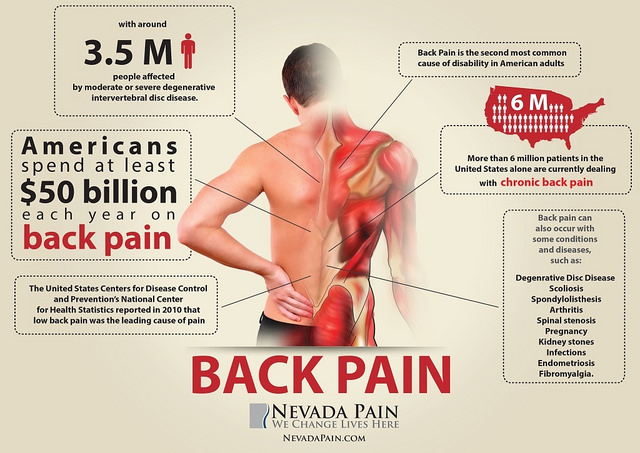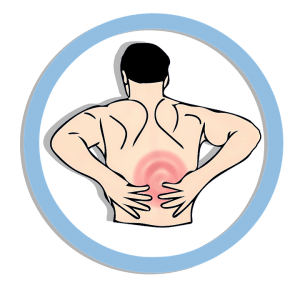Is the pain in your back becoming a major headache? Are you way in over your head when it comes to back pain? Many people worldwide suffer from back pain, but this does not mean you need to be one of them. After all, that which has a cure need not be endured. Whether you are suffering from back pain on account of old age, injury or illness, it’s time to take charge and use the right know-how and cures for leaving back pain behind.
Diagnosing the Issue
Table of Contents
The most important point when it comes to ridding yourself of back pain is to find the cause of the problem. Is it related to excess weight or an injury problem? Is there a gap in the spine? If the back pain persists, make sure to visit a specialist to diagnose the pain. Some of the many factors which cause back pain include:
Aging
Herniated disk
Arthritis
Compression fracture
Illness like scoliosis
If there is a lack of understanding about what is causing back pain or there may be ambiguities that need to be resolved, a medical practitioner is the best person to resolve any doubts.
Diagnostic Aids
The back will be examined by the doctor and the medical practitioner will assess the ability to sit, stand, lift the legs or walk. Doctors may also ask patients to rate the pain on a scale of 0 to 10 and check whether pain has impacted functionalities. This assessment determines where the pain originates from, how much can the pain be felt before forcing individuals to stop and whether one has muscle spasms. More serious cases of back pain can also be ruled out.
- X-Rays: X-rays are images showing the degree of alignment of the bones and whether there are instances of arthritis or broken bones. Such images don’t show issues with the spinal cord, nerves, muscles or disks.
- Blood Tests: Blood tests can be carried out to determine whether one has an infection or another medical condition triggering the pain.
- CT or MRI scans: CT/MRI scans generate images revealing herniated disks or bone, muscle, tissue, nerve, tendon, ligament and blood vessel problems.
- Nerve Studies: Electromyography or EMG measures the electrical impulses produced by nerves and muscles in response. This test confirms nerve compression caused by herniated disks or spinal canal narrowing/spinal stenosis.
- Bone Scans: Bone scans may be used in rare cases as a screening test for looking for bone tumors or compression fractures triggered by osteoporosis.
Resting the Back
Back muscles are used while bending forward, backward, exercising or moving in and around. Though the back is strong, it requires rest. Muscles need to be effectively rested and only then will the onset of pain lessen. Consider these cures for dealing with backache while you are asleep:
#1 Sleep on the Side
Try sleeping with a small pillow between the legs. This provides additional back support for the body and the back by straightening the legs while one rests.
#2 Use a Medium Firm Mattress
This puts the least pressure and stress on your back.
#3 Correct Bad Posture
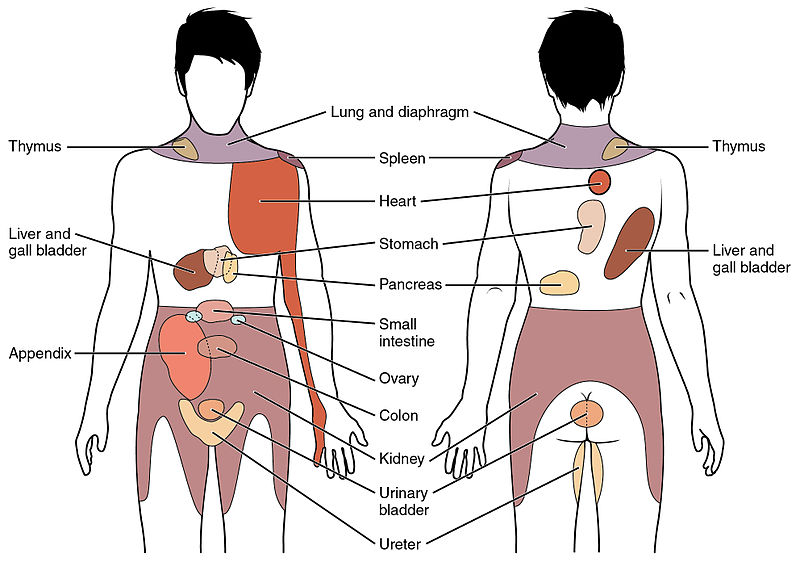
If you are resting in an awkward position, this can cause a real problem. A good amount of weight is supported by the back. For good posture, the spine should be curved slightly inward at the lower back. It should be projecting outward at the upper back and inward at the neck. If the shoulders are slouching, pull them back to ensure that they are in shape. Posture checks need to be performed anytime while sleeping or awake.
Support for Your Body
#1 Check Your Posture
Posture should be such that it provides support for your body and back. The posture checks should be periodically performed so that the chest is upright and elevated, the head is at the central position, over the torso and the shoulders are minimally strained and lowered to prevent injury.
#2 Have An Ergonomic Work Station
Ensure that your work station is posture friendly. We spend so many hours at work toiling away. This does not bode well for the back. Correct your desk at work to enhance your posture and ease back pain. For this, you need to keep your feet flat on the floor.
#3 Move Around
Change your posture and position on a regular basis as sitting in one position for longer time periods does not work well for health.
#4 Take a Break
This is another important point. After every hour of work, take a 5-minute break to walk around and break the tension. Consider standing desks or even a treadmill desk if you need to maintain good health at work and improve your posture.
What To Take for Back Ache
Treating Muscle Spasms
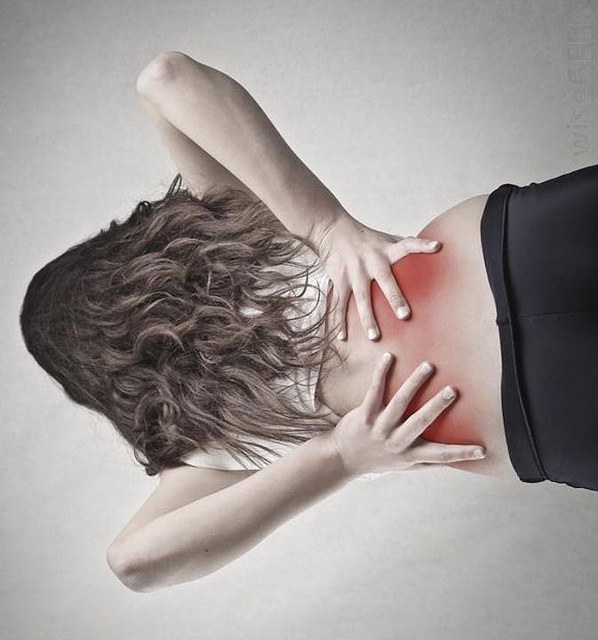
If muscle spasms take place, your body’s smooth muscles will contract due to the action of the ANS. This can signify a muscle tear. To solve the problem, straight the back moving back and forth to break the cycle of the spasm. But if exercise is causing pain, avoid it by seeing a doctor who can guide you regarding further treatment.
NSAIDs
Non-steroidal anti-inflammatory drugs or NSAIDs can also be taken for pain relief. These pain killers like aspirin and ibuprofen ease inflammation and pain by blocking chemical level enzymes. OTC drugs like these ease pain by controlling it at a chemical level. Aspirin should not be given to children, though adults can take it.
Other Medications For Pain
Depending on the type of back pain one suffers from, doctors can recommend OTC pain relievers as discussed above. In case these over the counter pain relievers don’t dispell pain, doctors can suggest prescription NSAIDs.
Muscle relaxants can also be prescribed. If mild or medium back pain does not get enhanced with OTC pain relief medication, doctors can prescribe a muscle relaxant. Then, there are topical pain relievers. These are creams, ointments or salves that are rubbed into the skin at the site of the pain. Narcotics containing opioids such as hydrocodone and oxycodone can be used for shorter time periods under medical supervision.
Antidepressants in low doses particularly tricycle antidepressants like amitriptyline relieve chronic back pain, irrespective of the impact on depression. When other measures don’t relieve the pain and if it radiates down the leg, doctors can inject cortisones which are anti-inflammatory medication or numbing medicines into the space around the epidural space/spinal cord. Cortisone injections can help in decreasing inflammation around nerve roots, but pain relief is less than a couple of months.
Ice Helps
Ice constricts blood vessels underneath the skin. This dulls pain and eases the swelling. Ice on the lower back can be used in numerous ways such as ice towels, homemade ice packs, frozen veggies, homemade slush pack, and of course, ice cubes in a damp towel.
Heat Eases Pain
Heat can also be a source of comfort and relief to ease back pain. For effective temperature therapy, the aim should be to alternate between heat and cold treatments. Moist heat includes baths, steams and heat packs. This works better than dry heat. Use all day heat wraps available at chemists. Heating pads can also work well.
Benefits of Exercise For Back Pain
It is better to opt for an exercise you enjoy, as you are most likely to adhere to it. Many forms of exercise help with back pain, such as walking, swimming, yoga, pilates or even going to the gym. Research has further found specially designed yoga programs can also help individuals with lower back pain lead more active lives and manage conditions effectively. Different people who took part in the study found they had the knowledge to prevent attacks if one feels an onset of episodic back pain.
Pain During Exercise
Remember that you may feel discomfort and pain when you exercise. While this is normal to some extent, note that acute plan needs to be medically attended to. Exercise helps to reduce pain can manage the back pain better. While pushing oneself and carrying out strenuous exercises, though, it is important not to exceed it. The key is starting off gently and increase the amount gradually. Sometimes, people stop exercising once the back pain clears up. This is not recommended. If one has trouble exercising, it is a good idea to check and ask for medical help from the GP or a referral to physiotherapists for tailored exercise tips. Personal trainers can offer expert advice.
Exercises to Manage Back Pain
Walking
Walking helps a lot. See if you can walk around for a good hour on the treadmill or outdoors. Use the inclines and slopes to make the circulation healthy. Walking is the best exercise for back pain according to some doctors because it boosts circulation and strengthens the back muscles
Knees to chest
Lie on the back with your knees bent. Bring a knee up and pull it gently onto the chest for five seconds. Repeat this for up to 5 times on every side.
Back Stretch
Lying on the back, hold your hands above your head. Bend the knees and roll them to one side, keeping the feet on the floor. This position must be maintained for ten seconds. Repeat this thrice on each side.
One-Leg Stand
Holding on to support if needed, bend a single leg up behind your body. Hold this position for five seconds. Then repeat thrice on each side.
Pelvic Tilt
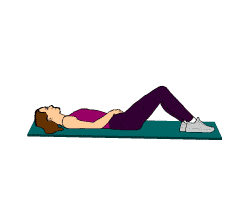
With your knees bent, lie down. Then, tighten the stomach muscles to flatten the back against the floor. This position needs to be held for 5 seconds and repeated for a minimum of 5 times.
Deep Lunge
Kneeling on one knee, hold the other foot in the front. Facing forward, lift the back knee upwards. This position needs to be held for five seconds and repeated thrice on each side.
Bottom To Heels Stretch
Kneeling on all fours, with knees under the hips, place your hands under your shoulders. Keeping the neck and back straightened, don’t lock the elbows. Then, slowly move the bottom back towards the heels. Holding the stretch for a single deep breath, then return to the starting position. This needs to be repeated between 8 and 10 times.
Another important thing is to avoid going back onto the heels if there is a knee problem. Use a mirror to position your body correctly, if required. Ensure that the stretch is only as far as one feels comfortable.
Knee Rolls
Lying on the back, place a flat and small cushion or book beneath the head. Keep knees bent and together. The upper body should be relaxed and the chin must be gently tucked in. Rolling the knees to one side, keep the shoulders on the ground. Hold the stretch for a single deep breath and return to the starting position. This needs to be repeated between 8 and 10 times, alternating the sides. Another important thing to do is move as far as comfort is felt, placing a pillow or cushion between the knees for comfort.
Deep Abdominal Strengthening
Lying on the back, place a small cushion or flat book under your head. bending the knees, keep feet in straightened position and apart by hips width. Keeping the upper body relaxed, ensure that your chin is gently tucked in. As the breath is released, gently tense the muscles in the pelvis and lower tummy so these are pulled towards the chest. Holding the position for anywhere between 5 and 10 breaths, relax your body. Repeat this exercise for a total of 5 times.
This is a slow, gentle exercise, where the muscles don’t need to be tensed too quickly or hardly. Tensing up the legs, shoulders or neck should be avoided.
Back Extension
Lying on the front and resting on the forearms, ensure your elbows are bent at the side. Gaze at the floor and keep the neck straightened. Then, you need to arch the back by pushing on the hands, while keeping the neck straightened. Feel a gentle stretch in the muscles of the stomach. Then, breathe and hold this position for anywhere between 5 and 10 seconds. Then, return to the starting position. Make sure you repeat it between 8 and 10 times. However, don’t bend the neck backward and ensure your hips are on the floor.
Simple Posture-Based Exercises For Back Pain
Exercise #1
Use this pose with your knees bent and your feet together. The sides of the thighs should reach the ground. With your hands clutching the feet, lower the torso keeping the thighs and glutes on the ground. Stay in this position for 10-15 seconds before returning to the original position.
Exercise#2
Lie flat on the back on a mat. Bring both the legs backward, bending the knees so that the thighs are parallel to the floor and the legs are at a right angle. Then, hold the outside of your feet with your hands and strengthen the upper body. Now press the knees to the floor and stay in this pose for 15 seconds after which you must gradually release yourself from it.
Exercise#3
Sit with the left leg crossed ahead of you. The right leg is extended fully behind. Now point your right hip to your feet with your hands on your hips and your back gently stretching. Move the hands out ahead of you and move the torso over the crossed knee. Stay here for 10-15 seconds before slowly moving back up.
Other Treatment Measures
Try back therapies such as walking, back stretches, and core stabilization. There are numerous massages, good for the back such as the Swedish massage. Spinal manipulations yield results right away. Ancient Chinese medicine system acupuncture using nettles and pressure points also works. Reduce emotional stress if you want to secure a pain-free back for yourself. Ice may lower inflammation, but workouts are needed to maintain the proper alignment and posture of the spine.
Try meditation and exercise in a combination to release neurotransmitters like serotonin and feel-good hormone endorphins. Tai Chi, Physical Therapy and Aquatic therapy are some of the other methods for treatment. Eventually, the cure for back pain depends on what works best for your body type and condition, based on the reasons for the pain in the first place. Effective diagnosis and treatment can make a massive difference to the final outcome. Choose a qualified medical practitioner and sheer will power and initiative to combat backache and lead a pain-free life.
Treating Back Pain
Back pain is common but is not caused by a serious problem in some cases. Research also shows most cases of back pain improve on their own within a couple of weeks. Staying active is important. Bed rest for more than just a couple of days makes it harder to get moving. Increasing normal activities and performing regular exercise is the key. Pain should ideally ease within 2 weeks if pain management and treatment is sought. Over a 4 to 6 week period, pain should recover. Carry on the exercise for a minimum of anywhere from 6 to 8 weeks to help prevent more injuries. In the event that pain is severe, or not going away after a week or more, contact your doctor.
Besides benefiting the back, exercise also launches endorphins. These are natural painkillers in the body. Exercise can cause the back to feel sore but it does not lead to any harm. Start slowly and increase the exercise carried out. Exercises that help include those that enable you to stay active. Keeping the spinal muscles strong provides support for joints and bones and takes pressure off them.
If you are inactive for a long time period, muscles in the back become weaker and one becomes less fitter. This can worsen back pain. Regular exercise leads to less frequent and more short episodes of back pain. Exercise also leads to the release of endorphins which improve pain and make individuals feel stronger. Aim to go exercises every day. If pain does not improve, or severe pain is experienced while trying out these exercises, make sure you see a general practitioner.
Alternative Therapies/Medicines
Numerous alternative treatments ease back pain symptoms. The benefits and risks need to be discussed with the doctor before starting alternative therapies such as these:
- Chiropractitioner: Chiropractors can use manual therapy on the spine to ease the pain.
- Acupuncture: This involves inserting sterilized needles of stainless steel within the skin. This can be inadequate on specific body points. Some individuals with low back pain report acupuncture relieve symptoms.
- TENS/Transcutaneous Electrical Nerve Stimulation: TENS uses battery-powered devices placed on the skin to deliver electrical impulse to painful areas.
- Yoga: There are many types of yoga. In fact, yoga is a broad discipline that involves specific breathing exercises, relaxation techniques and poses. Yoga strengthens and stretches the muscles to improve the posture, although these need to be modified if symptoms are aggravated.
- Massage: if back pain is caused by tension or overworked muscles, massages can help.
Managing Back Pain
Important ways to cope with back pain and manage it is to keep moving, continue with daily activities and have a healthy lifestyle. When it comes to back pain, specific activities like twisting, turning or lifting things can make the spine worse and intensify back pain. It is also important to remember backs and spines are strong and designed to move. Moreover, excessive rest can make back pain infinitely worse. High activity levels may actually speed up recovery. Being positive is important, too. Remember the more active you are, the better your back will be. But if there are concerns, a healthcare professional would be able to help you out the best.
Staying active is essential for improving back pain.
Therapies for Back Pain
#1 Physiotherapy
Physiotherapy can improve flexibility and strength. Exercise is an effective back pain treatment. Physiotherapists can oversee exercise programs and recommend specific exercises for helping. Manual therapies also known as ‘hands-on’ treatments such as spinal joint mobilization and manipulation can clear up back pain spells along with exercises. Manual therapies are carried out by physiotherapists, osteopaths, and chiropractors. These therapies are not suited for all the back conditions. Check if the doctor approves these before trying it.
#2 Talking Therapies
Back pain that lasts for a long time can impact an individual’s mood. If one is really feeling anxious or low it is important to talk to individuals like partners, friends, relatives or doctors. Talking therapies can be extremely useful. For example, cognitive behavioral therapy can help individuals to cope with back pain.
The aim is to help individuals cope with problems in a positive manner, by breaking these into smaller parts. Doctors may be able to refer for CBT if required. Keeping physically and socially active is important for warding off low moods and lowering anxiety levels. Besides this, it also helps with the pain. Simple activities like joining a local leisure center, sports club, gardening group, walking group or just attending a friendly get-together.
#3 Occupational Therapy
If the back pain is coming in the way of every day functions such as driving, dressing, and washing, it may benefit one to opt for occupational therapy. There are different ways of reducing the strain or recommending aids/gadgets that help. It is also important one does not come to rely excessively on these. Occupational therapy can help you to get back to everyday activities, though.
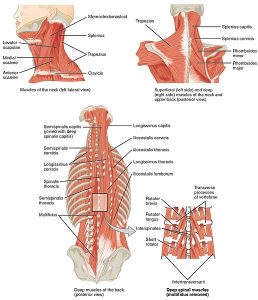
Working With Back Pain
Getting back to work sooner than later can help most individuals cope with back pain. This helps the back pain, too as staying active and keeping the muscles in the back moving helps one to get better sooner. It also makes one feel better about themselves as time off work impacts individual moods. In the past, many individuals were advised to rest in bed. However, this was found to do more harm than benefits. It is better to keep moving, especially with the aid of simple painkillers.
Most individuals are able to return within two to three days, though the length of time off work varies with individuals and the type of job carried out. One does not need to wait until the back problem is completely resolved. In many cases, the longer one avoids work, the more chances of developing long term, chronic back problems exist.
It is important to be clear and discuss what needs to be done to return to work. If work involves physically demanding tasks like heavy lifting, one may need to carry out lighter duties for lesser hours. If there is an occupational health advisor through the job, they can help in staying fit and adjusting to the workplace to help you ope better.
Daily Habits to Stop Back Pain
Bending the wrong way while lifting heavy items can be a real problem. Back pain can also result from degenerative conditions like arthritis. Irrespective of the cause, once there is lower back pain, it can be tough to get rid of. Approximately 1 in 4 Americans have had recent low back pain bouts. Almost everyone can experience back pain at some point in life.
Sometimes, it can be really serious. This is more so when one feels numbness, weakness or tingling in the legs or serious injuries are experienced. For routine back pain, though, here are the daily habits you must inculcate:
Exercise Regularly
Like the rest of the human body, our spines are meant to move. Keeping up everyday activities is important, irrespective of whether these are simple aerobic exercises like walking, swimming, and cycling or complex exercises.
Stay Strong
Once the low back pain has receded, future episodes of back pain can be averted by working muscles supporting the lower back. This includes the exterior back muscles. This can help in maintaining proper posture and alignment of the spine. A strong hip, pelvic and ab muscle combination provides the back with more support. Abdominal crunches should be avoided because they strain the back.
Stretching is Essential
Sitting slumped in the desk chair all the days is not advisable. Get up every 20 minutes or so and stretch the other way. As most individuals spend time bending forward, it is important to stand up and stretch back across the day. Stretching the legs is also important. You can also find relief from back pain through regular stretching routines such as yoga.
Thinking Ergonomically
Your workspace should be designed to ensure you don’t have to bend forwards to see the computer monitor or reach for the mouse. A desk chair supports the lower back and permits the feet to remain planted firmly on the floor.
Study The Posture
Slumping makes it tougher for the back to support the weight. It is essential to be careful of the posture while lifting heavy objects. Bending over from the waist is not advisable. Instead, bend and stand straight from the knees.
Wear Low Heeled Shoes
Exchange your 4-inch pumps for flats or low-heeled shoes less than one inch. High heels can create an unstable posture and increase lower spine pressure.
Avoid Smoking
Smoking increases the risk of osteoporosis. It also leads to other spine and bone problems. Osteoporosis can lead to compression fractures of the spine. Recent research found smokers were likely to have lower back pain as against nonsmokers.
Watching the Weight
Using diet and exercise is the key to keep the weight within a healthy range for your height. This is because being obese or overweight places additional stress on the spine. Although back pain can be complicated, many different actions are needed to alleviate back pain or ward off serious, chronic back conditions. Changing some daily habits everyday helps in maintaininga pain-free, healthy back for a long time period.
Work the Core
Working your core is beneficial, too. There are multiple health benefits of exercise. A regular strength training routine focusing on core muscles can reduce the chances of back linked injuries like muscle spasms and strains. Use back and abdominal strengthening exercises twice a week to develop stronger and more flexible back muscles.
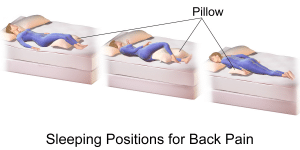
Sleep with the Pillow Under the Knees
Eliminate pressure on the back especially if you sleep on your back. Spinal tension can be released by elevating the legs slightly to relieve pressure on the back as one sleeps. Cut the pressure by placing a pillow beneath the knees.
Increase Vitamin D plus Calcium Intake
Strong bones can be crucial for preventing osteoporosis. This is one of the most common reasons for back pain in later life, especially for women. Use vitamin D and Calcium to ward off bone weakness and keep the spine strong. Calcium can be found in yogurt, milk, vitamin supplements, and leafy greens. Vitamin D, on the other hand, can be found in egg yolks, beef liver, cheese, and fatty fish. Consult your doctor before taking any supplements.
Straighten Your Back
Good posture does not benefit you aesthetically alone. It also pushes the intricate parts of the spine to ensure they function in a healthy and proper way. Bad postures strain the back and change the spine’s structure. Slouching, rouding shoulders or bending sideways while standing can be a real problem. While sitting at your office desk, use the same postures and support your back while sitting down. Use a quality chair to provide firm support for the lower back.
Conclusion
Thus, the secrets to a healthy back lie in adequate exercise, good dietary practices, and enough support and activity to strengthen the core. Remember that while exercising is the key to a strong spine and a healthy back, it is essential to be able to know when the pain is unmanageable and you need medical care. Mild pain that is irregular can be coped with using exercise, diet and home remedies, but for excruciating back pain, it is advisable to go to a doctor. Back pain is not a condition to be taken lightly. So take these crucial steps and ensure that you develop a strong, flexible and healthy back.

